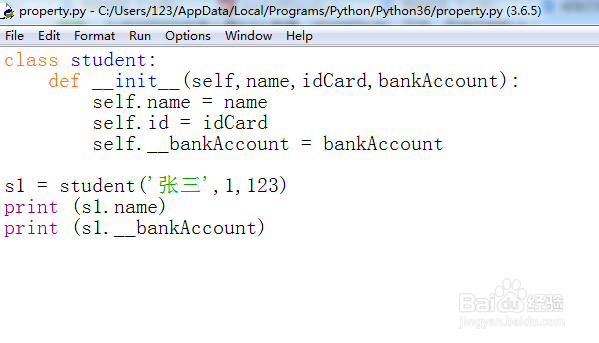Python类私有字段和属性使用
1、打开Python开发工具IDLE.新建‘property.py’文件,并写代码如下:
class student:
def __init__(self,name,idCard,bankAccount):
self.name = name
self.id = idCard
self.__bankAccount = bankAccount
s1 = student('张三',1,123)
print (s1.name)
print (s1.__bankAccount)
定义了一个student类,并实例化s1对象,__bankAccount是类的私有字段,python中私有字段以两个下划线开头

2、F5运行程序,Shell中打印信息如下:
张三
Traceback (most recent call last):
File "C:/Users/123/AppData/Local/Programs/Python/Python36/property.py", line 9, in <module>
print (s1.__bankAccount)
AttributeError: 'student' object has no attribute '__bankAccount'
程序报错,是因为私有字段不能类外直接访问。

3、Python中通过属性的方式来访问私有字段,代码如下:
class student:
def __init__(self,name,idCard,bankAccount):
self.name = name
self.id = idCard
self.__bankAccount = bankAccount
@property
def AccountNo(self):
return self.__bankAccount
s1 = student('张三',1,123)
print (s1.name)
print (s1.AccountNo)
在类的方法上加@property 就标注为属性,注意在使用时不需要加括号,像直接访问字段一样就行。

4、F5运行程序,私有字段的值被打印出来:
张三
123

5、需要更改私有字段的值也是通过属性方式。代码如下:
class student:
def __init__(self,name,idCard,bankAccount):
self.name = name
self.id = idCard
self.__bankAccount = bankAccount
@property
def AccountNo(self):
return self.__bankAccount
@AccountNo.setter
def SetAccountNo(self,bankAccount):
self.__bankAccount = bankAccount
s1 = student('张三',1,123)
s1.SetAccountNo = 321
print (s1.name)
print (s1.AccountNo)
@AccountNo.setter是AccountNo属性的赋值函数,注意使用时候直接用‘=’就行。

6、F5运行程序,私有字段的值被成功赋值并打印出来:
张三
321
